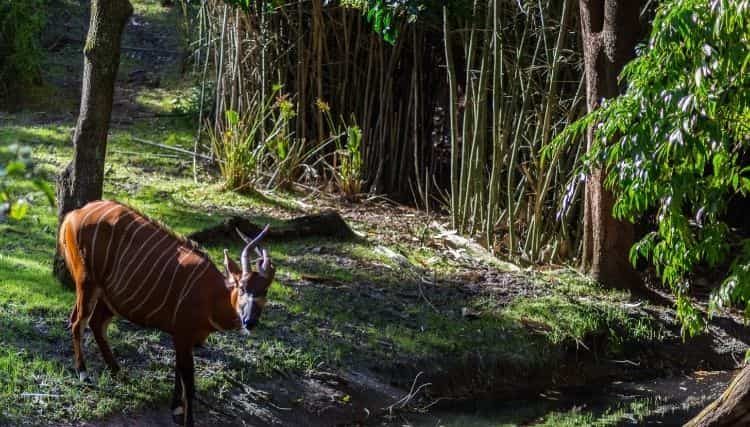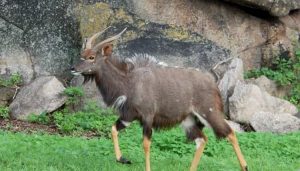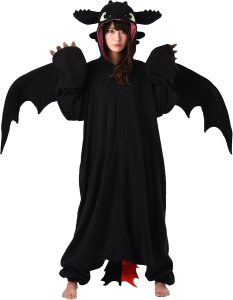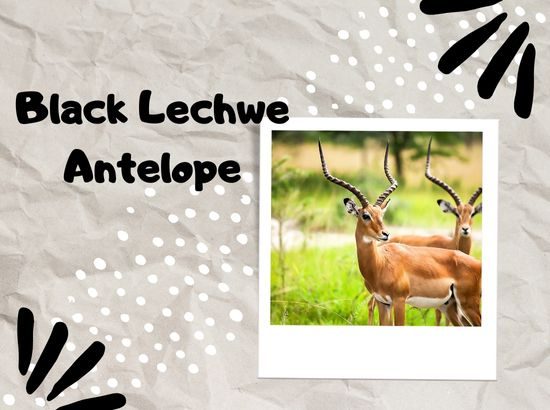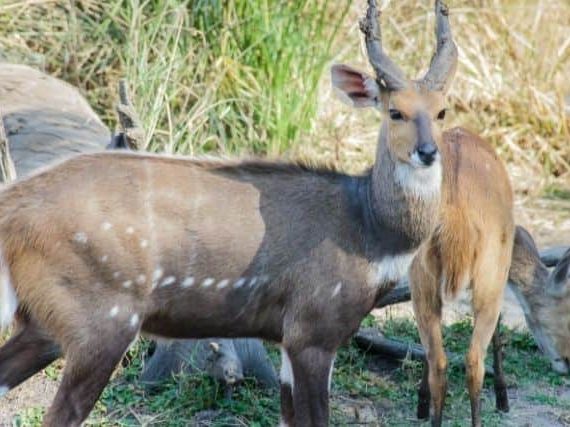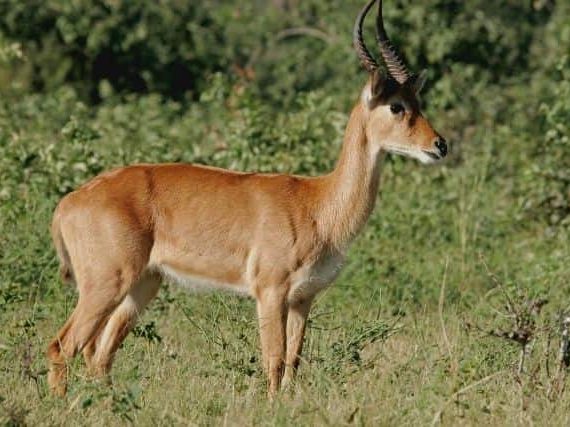It can be tough to get the information you need about animals. If you’ve ever wanted to know all there is to know about Lowland Bongo Antelope, then this guide is for you.
What is Lowland Bongo Antelope?
The Lowland Bongo Antelope (Tragelaphus eurycerus procerus) is a subspecies of the Bongo Antelope, which is found in the lowland rainforests of Central and West Africa, including countries like Cameroon, Central African Republic, Congo, and Gabon.
It is one of the largest and most colorful forest antelopes, with a striking reddish-brown coat, vertical white stripes, and long, spiral horns that can reach up to 39 inches (100 cm) in length.
The Lowland Bongo Antelope is primarily nocturnal and feeds on a variety of vegetation, including leaves, fruits, and grasses. It is also an excellent swimmer and can dive underwater to avoid predators.
What is Lowland Bongo Antelope Size?
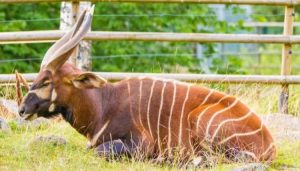
What is Lowland Bongo Antelope Size?
The Lowland Bongo Antelope is one of the largest forest antelopes and can grow up to 6 feet (1.8 meters) in length and up to 4.5 feet (1.4 meters) in height at the shoulder. Adult males can weigh between 400-550 pounds (180-250 kg), while females are slightly smaller, weighing between 300-460 pounds (140-210 kg).
The most striking feature of the Lowland Bongo Antelope is its long, spiral horns, which can reach up to 39 inches (100 cm) in length in males and 22 inches (55 cm) in females.
Where Does The Lowland Bongo Antelope Live?
The Lowland Bongo Antelope lives in the lowland rainforests of central Africa. It is found in Cameroon, Central African Republic, Congo, Equatorial Guinea, Gabon, and Nigeria.
What is The Lowland Bongo Antelope Habitat?
The Lowland Bongo Antelope (Tragelaphus eurycerus eurycerus) is a forest-dwelling antelope that is found in the lowland rainforests of central and West Africa.
They prefer dense, primary, and secondary forests, but can also be found in forest clearings and areas near rivers. Lowland Bongo Antelopes are adapted to living in humid and rainy environments and are known to inhabit areas with high rainfall and dense vegetation.
Their habitat typically includes a variety of plant species such as trees, vines, and shrubs, which provide shelter and food for the animals. They are also known to inhabit areas with water sources such as rivers and streams, as they are excellent swimmers and can dive underwater to avoid predators.
Unfortunately, the Lowland Bongo Antelope’s habitat is under threat due to deforestation, hunting, and human encroachment, which has led to a decline in their populations in some areas. Conservation efforts are underway to protect their remaining habitats and populations.
What is The Physical Description Of Lowland Bongo Antelope?
The Lowland Bongo Antelope (Tragelaphus eurycerus eurycerus) is one of the largest and most striking forest antelopes, with a distinct physical appearance. Here are some of the key physical features of the Lowland Bongo Antelope:
-
Size: Lowland Bongo Antelopes can grow up to 6 feet (1.8 meters) in length and up to 4.5 feet (1.4 meters) in height at the shoulder. Males are larger than females.
-
Weight: Adult males can weigh between 400-550 pounds (180-250 kg), while females are slightly smaller, weighing between 300-460 pounds (140-210 kg).
-
Coat: They have a dark reddish-brown coat with 10 to 15 vertical white stripes on their sides, which are used as camouflage in the forest. The stripes help to break up their silhouette and blend in with the dappled light in the forest.
-
Horns: Lowland Bongo Antelopes have long, spiraled horns that can reach up to 39 inches (100 cm) in length in males and 22 inches (55 cm) in females. Both males and females have horns, but the male’s horns are larger and thicker.
-
Ears: They have large, rounded ears that are sensitive to sounds in their environment.
-
Legs: Their legs are relatively long and slender, which helps them to move easily through dense vegetation.
Overall, the Lowland Bongo Antelope is a beautiful and distinctive animal, well adapted to its forest habitat.
Lowland Bongo Antelope Reproduction -Breeding
The breeding season of the Lowland Bongo Antelope (Tragelaphus eurycerus eurycerus) typically occurs during the rainy season, which is when food is abundant in the forest. During this time, males compete for the attention of females, and they use their long, spiraled horns to fight for dominance.
After mating, the female will have a gestation period of around 9 months before giving birth to a single calf, which weighs between 35-50 pounds (16-23 kg) at birth. The newborn calf can stand and walk within hours of birth and will stay close to its mother for the first few months of its life. The mother will nurse the calf for about six months before it begins to eat solid food.
Lowland Bongo Antelopes reach sexual maturity at around 2-3 years of age. While females typically give birth to one calf per year, in some cases, they may give birth to twins, although this is rare.
Lowland Bongo Antelopes are social animals and form small groups consisting of females and their young, led by a dominant male. Males are territorial and will mark their territories with scent markings and vocalizations. However, during the breeding season, males will compete for access to females and may roam outside their territories in search of mates.
Lowland Bongo Antelope Mating Season
The Lowland Bongo Antelope Mating Season is a time of year when the males are most aggressive and territorial.
The Lowlands are the only place in the world where this animal lives, and it has an interesting mating season. The males are most aggressive during this time, which is May to August.
They will fight with other males for dominance, females to mate with them, and even chase off predators that might threaten their offspring.
How Long Does A Lowland Bongo Antelope Live?
The lifespan of a Lowland Bongo Antelope (Tragelaphus eurycerus eurycerus) in the wild can vary depending on various factors such as predation, disease, and habitat quality. In general, they have an average lifespan of around 10-12 years in the wild.
However, in captivity, where they are protected from many of the threats they face in the wild, Lowland Bongo Antelopes can live much longer. Some individuals have been known to live up to 24 years in captivity.
The age of a Lowland Bongo Antelope can be determined by examining the wear and tear on its teeth. As they age, their teeth become more worn down, which can affect their ability to chew and digest food properly.
Overall, the lifespan of a Lowland Bongo Antelope is influenced by a range of factors, including genetic makeup, environmental conditions, and individual health. Conservation efforts are important to ensure that the species continues to thrive and contribute to the diversity of life in the world’s forests.
Lowland Bongo Antelope Communication And Perception
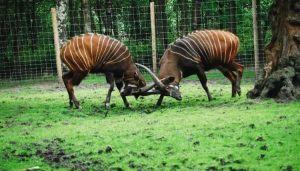
Lowland Bongo Antelope Communication And Perception
Lowland Bongo Antelopes (Tragelaphus eurycerus eurycerus) use a variety of vocalizations, body postures, and scent markings to communicate with one another. They have a complex social structure that involves both territorial males and groups of females and their young.
Males are territorial and will use scent marking to define and defend their territories. They will also use vocalizations such as grunts, snorts, and bellows to communicate with other males and females in their area. Males will also use their long, spiraled horns to fight for dominance and to establish their position within the social hierarchy.
Females and their young form groups that are led by a dominant male. They communicate with one another through vocalizations, such as contact calls between mothers and their calves, and through body postures, such as ear and tail movements.
Lowland Bongo Antelopes also have a keen sense of smell, which they use for communication and to navigate their environment. They use their sense of smell to detect the presence of predators, locate food and water sources, and communicate with other individuals through scent marking.
In summary, Lowland Bongo Antelopes use a variety of vocalizations, body postures, and scent markings to communicate with one another and navigate their environment. Their social structure and communication methods are critical to their survival and reproduction in the wild.
What Does Lowland Bongo Antelope Eat?
Lowland Bongo Antelopes (Tragelaphus eurycerus eurycerus) are herbivores and primarily feed on a variety of leaves, fruits, and other vegetation. Their diet includes a range of plant species, including young leaves, flowers, and fruits, as well as grasses and herbs.
Lowland Bongo Antelopes have a specialized digestive system that allows them to extract as many nutrients as possible from their food. They have a four-chambered stomach, which allows for a longer digestion process, and they regurgitate and re-chew their food to further break it down and extract nutrients.
They are also known to visit mineral licks, which are patches of soil or rocks rich in minerals, such as salt, which they consume to supplement their diet and meet their mineral requirements.
Overall, the Lowland Bongo Antelope’s diet is well adapted to their forest habitat and the availability of vegetation and minerals in the area. However, habitat loss and fragmentation, as well as hunting and other threats, can make it difficult for them to access the resources they need to survive.
What is Lowland Bongo Antelope Role İn The Ecosystem
The Lowland Bongo Antelope (Tragelaphus eurycerus eurycerus) plays an important role in its ecosystem as a herbivore and a prey species. As a herbivore, it helps to maintain the balance of the forest ecosystem by consuming a variety of vegetation and providing food for predators.
Lowland Bongo Antelopes are also important prey species for a range of predators, including lions, leopards, hyenas, and wild dogs. Their presence in the ecosystem helps to support these predator populations, which in turn helps to control the population sizes of other herbivores in the area.
In addition, Lowland Bongo Antelopes are important seed dispersers, as they consume fruits and other plant material and spread seeds throughout the forest. This helps to support the growth and regeneration of plant populations and contributes to the overall health and diversity of the forest ecosystem.
Overall, the Lowland Bongo Antelope plays a critical role in the ecosystem as a herbivore, prey species, and seed disperser. Conservation efforts are important to ensure that they continue to thrive and contribute to the health and diversity of forest ecosystems in their range.
Lowland Bongo Antelope Conservation Status
The Lowland Bongo Antelope (Tragelaphus eurycerus eurycerus) is currently listed as Near Threatened on the IUCN Red List of Threatened Species. The population of Lowland Bongo Antelopes is declining primarily due to habitat loss, fragmentation, and hunting for their meat and horns.
The Lowland Bongo Antelope is primarily found in the rainforests of Central and West Africa, which are under threat due to deforestation for timber, agriculture, and human settlements. This has led to the fragmentation and loss of the antelope’s habitat, making it more difficult for them to find suitable food and water sources, and to mate and reproduce.
In addition, the Lowland Bongo Antelope is hunted for its meat, which is considered a delicacy in many parts of Africa, and for its horns, which are used in traditional medicine and as a status symbol.
Conservation efforts for the Lowland Bongo Antelope include the protection and restoration of their habitat, the establishment of protected areas, and anti-poaching measures to reduce hunting and trade in their meat and horns. Captive breeding and reintroduction programs are also being implemented to help boost populations and increase genetic diversity.
Overall, the conservation status of the Lowland Bongo Antelope is a concern, and efforts are being made to protect and conserve this species and its habitat for the benefit of both the species and the ecosystem it inhabits.
How Many Lowland Bongo Antelope Are Left İn The World?
There are no recent estimates on the population of lowland bongo antelope in Africa, but it is estimated that there are 30,000 left in the world.
How Fast a Lowland Bongo Antelope Run?
While there is no exact figure on the top speed of a Lowland Bongo Antelope, they have been observed running at speeds of up to 40 km/h (25 mph) when chased by predators such as lions or leopards.
However, they are generally not known for their speed and tend to rely on their excellent camouflage and agility to avoid predators in their dense forest habitat.
- Referans: African wildlife
- Safari west
Do lions eat lowland bongo antelope?
Lions are carnivores and they prey on lowland bongo antelope.
Why are bongos hunted?
Bongos are hunted for their meat, skin, and fat. They are also hunted because they compete with livestock for food and water.
In some parts of Africa, people hunt bongos for food. In other parts, they are hunted for their hides which are used to make drums and other items. In still other areas, the animals are hunted for sport or to keep them from destroying crops or livestock.
What do you call a group of bongos?
A group of bongos is called a “conga line.”
Are bongos endangered?
Bongos are endangered because they are hunted for their meat. Bongos are also at risk due to the rapid destruction of the rainforest where they live.
The hunting of these animals has been increasing because there has been an increase in the number of people living in poverty who cannot afford to buy meat at the market.
Do bongos migrate?
Bongos are not migratory animals. They stay in the same place for their entire life.
Why are Lowland Bongo Antelopecalled bongos?
The Lowland Bongo Antelope is called a bongo because they make a sound that is similar to the drumming of the bongos.
What zoo has a bongo?
The zoo that has a bongo is the Bronx Zoo in New York City and Los Angeles Zoo and Botanical Gardens
How long are bongos horns?
The length of the bongo’s horn depends on its size and can range from 75cm – 99cm

